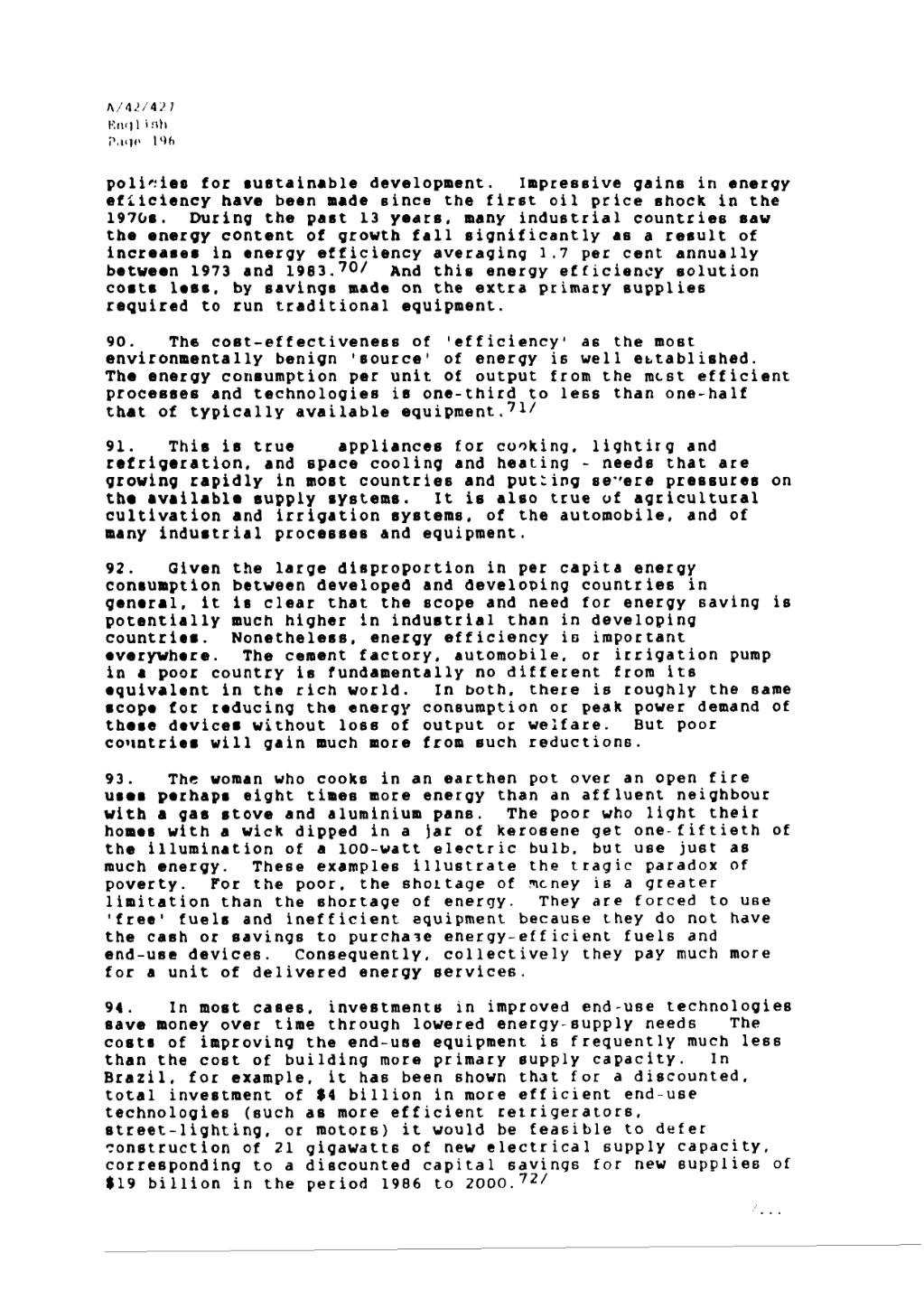A/42/427
English
Page 196
policies for sustainable development. Impressive gains in energy efficiency have been made since the first oil price shock in the 1970s. During the past 13 years, many industrial countries saw the energy content of growth fall significantly as a result of increases in energy efficiency averaging 1.7 per cent annually between 1973 and 1983.[1] And this energy efficiency solution costs less, by savings made on the extra primary supplies required to run traditional equipment.
90. The cost-effectiveness of 'efficiency' as the most environmentally benign 'source' of energy is well established. The energy consumption per unit of output from the must efficient processes and technologies is one-third to less than one-half that of typically available equipment.[2]
91. This is true of appliances for cooking, lighting and refrigeration, and space cooling and heating – needs that are growing rapidly in most countries and putting severe pressures on the available supply systems. It is also true of agricultural cultivation and irrigation systems, of the automobile, and of many industrial processes and equipment.
92. Given the large disproportion in per capita energy consumption between developed and developing countries in general, it is clear that the scope and need for energy saving is potentially much higher in industrial than in developing countries. Nonetheless, energy efficiency is important everywhere. The cement factory, automobile, or irrigation pump in a poor country is fundamentally no different from its equivalent in the rich world. In both, there is roughly the same scope for reducing the energy consumption or peak power demand of these devices without loss of output or welfare. But poor countries will gain much more from such reductions.
93. The woman who cooks in an earthen pot over an open fire uses perhaps eight times more energy than an affluent neighbour with a gas stove and aluminium pans. The poor who light their homes with a wick dipped in a jar of kerosene get one-fiftieth of the illumination of a 100-watt electric bulb, but use just as much energy. These examples illustrate the tragic paradox of poverty. For the poor, the shortage of money is a greater limitation than the shortage of energy. They are forced to use 'free' fuels and inefficient equipment because they do not have the cash or savings to purchase energy-efficient fuels and end-use devices. Consequently, collectively they pay much more for a unit of delivered energy services.
94. In most cases. investments in improved end-use technologies save money over time through lowered energy-supply needs. The costs of improving the end-use equipment is frequently much less than the cost of building more primary supply capacity. In Brazil, for example, it has been shown that for a discounted, total investment of $4 billion in more efficient end-use
technologies (such as more efficient refrigerators, street-lighting, or motors) it would be feasible to defer construction of 21 gigawatts of new electrical supply capacity, corresponding to a discounted capital savings for new supplies of $19 billion in the period 1986 to 2000.[3]
/…
- ↑ OECD. op. cat.
- ↑ E. Hirst et A1., 'Recent Changes in U.S. Energy Consumption, What Happened and Why?' in D.J. Rose (ed.). Learning About Energy (New York: Plenm Press. 1986).
- ↑ H.. Geller, 'The Potenial for Electricity Conservation in Brazil', Companhia Enegetica de Sao Paulo. Sao Paulo. Brazil, 1985.
